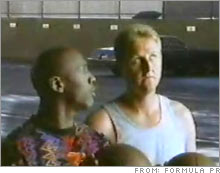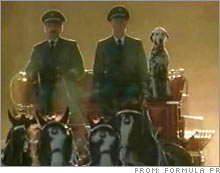Super Bowl ads through the agesA spot cost $1.2 million 10 years ago. Now, it's $2.6 million. Don't expect prices to fall anytime soon.NEW YORK (CNNMoney.com) -- Indianapolis? Chicago? Who cares? For many, the battle between Anheuser-Busch, FedEx and CareerBuilder for funniest commercial is what matters on Super Bowl Sunday. The hype around Super Bowl spots has reached a fever pitch this year.
CBS (Charts), which will be broadcasting Super Bowl XLI from Miami on Sunday, is said to be charging as much as a record $2.6 million for a 30-second commercial, up slightly from the $2.5 million Walt Disney (Charts)-owned ABC got for an ad last year. But it wasn't that long ago that a 30-second Super Bowl ad cost "just" $1.2 million. That was the going rate for a spot in 1997, according to figures from research firm TNS Media Intelligence. And 10 years earlier, Super Bowl ads cost just $600,000. So the price of a commercial has more than quadrupled in the past twenty years. And guess what? It's likely to get even crazier next year with Super Bowl XLII. That's just the way it is. "I can't imagine the ad rates will ever go down," said Walter Guarino, an advertising professor at Seton Hall University. "The ads are a fall-back, a fail-safe to keep up the entertainment value going if the game is a bomb. They've now taken front and center stage." What's more, the networks are milking more and more ad money from the Super Bowl by showing even more commercials. According to TNS, there was over 47 minutes of commercials (including house ads for ABC programs) on last year's telecast, up from 37 minutes just five years ago. But you probably won't hear Super Bowl-watchers complain. The game is arguably now more about the ads than the action on the gridiron. Michael Pavone, president of Pavone, a brand consulting firm in Harrisburg, Pa. that runs Spotbowl, a Web site where viewers can vote for their favorite commercials, said Apple's (Charts) famous "1984" ad for the Macintosh changed everything. It raised the bar for how lavish a Super Bowl ad could be and since then hype about the ads has been so intense that the discussion of the commercials leading up to the game often overshadows the game itself. "People anticipate the Super Bowl commercials like they do movie premiers," said Steve McKee, president of McKee Wallwork Cleveland Advertising, an agency that runs Adbowl, another site that tracks opinions about Super Bowl commercials. To that end, Pavone cited a 2005 survey by consulting firm Penn, Schoen and Berland that showed just how much interest there is in the game compared to the commercials. According to the survey, 58 percent of respondents said they'd rather miss some of the game than any of the ads. What's more, 58 percent also said they talk about the commercials at work on Monday compared to just 47 percent who talk about the game. And people don't just have interest in this year's commercials. There is a sense of nostalgia for "classic" Super Bowl ads. Go to YouTube, the popular video site owned by Google (Charts), and you'll find that several users have posted the Apple 1984 commercial and that those posts have been viewed by more than 200,000 people in the past year. CBS is even running a prime-time special on Friday called "Super Bowl's Greatest Commercials" which will showcase ads such as the Apple spot, the Michael Jordan versus Larry Bird "Nothing but net" commercial for McDonald's (Charts) in 1993 and EDS' "Cat herder" spot from 2000. Viewers will have a chance to vote for their favorite to see if it could dethrone Coca-Cola's (Charts) 1980 Mean Joe Greene ad as the most popular Super Bowl commercial ever. The network aired a similar show last year (even though it wasn't broadcasting the game) that was watched by more than 9 million viewers. The program's executive producer said that even though there isn't much new in this year's show, there is still heavy interest in it. "The success of our show is pretty amazing in that you are not dealing with a lot of new material. By and large, it's the same commercials. But you want to see them again. It's like reliving those great TV moments and people don't mind seeing them year-in and year-out," said Bob Horowitz, executive producer for "Super Bowl's Greatest Commercials." Still, the question begs to be asked. Do Super Bowl commercials really work? It's one thing to be able to vividly remember last year's popular spot from Anheuser-Busch (Charts) featuring a lamb streaking during one of the Clydesdale horses' football games or even the famous 1973 Joe Namath-Farrah Fawcett Noxzema shaving cream ad. But do the commercials actually make you more likely to drink Bud and shave with Noxzema? One marketing executive says too many Super Bowl advertisers these days think more about making people laugh instead of making people want to buy your product. "An ad can be entertaining with sophomoric humor as long as it gives you an idea of what the commercial is selling," said Spyro Kourtis, president of the Hacker Group, an ad agency in Bellevue, Wash. "A million viewers are not as valuable in my mind as 100,000 customers and that's the perspective that more advertisers should have." But even if there is a debate about how effective a Super Bowl ad really is, there is no question that without the commercials, Sunday's game would lose a lot of its allure to the many people who are only familiar with Peyton Manning because they've seen him in a commercial. "There are no shows on network TV that if you took the commercials out, the ratings would go down," said Horowitz. "It's the opposite with the Super Bowl. Here, if you took the commercials away, you'd probably lose 25 percent of the audience." |
Sponsors
|




